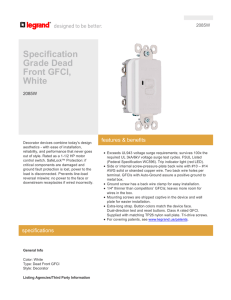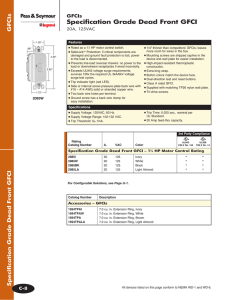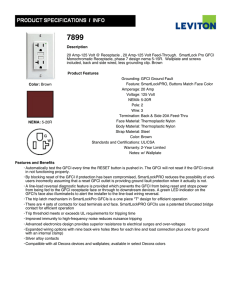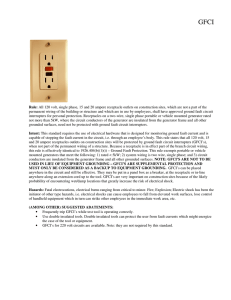Production Power on a budget: Ground-fault
advertisement
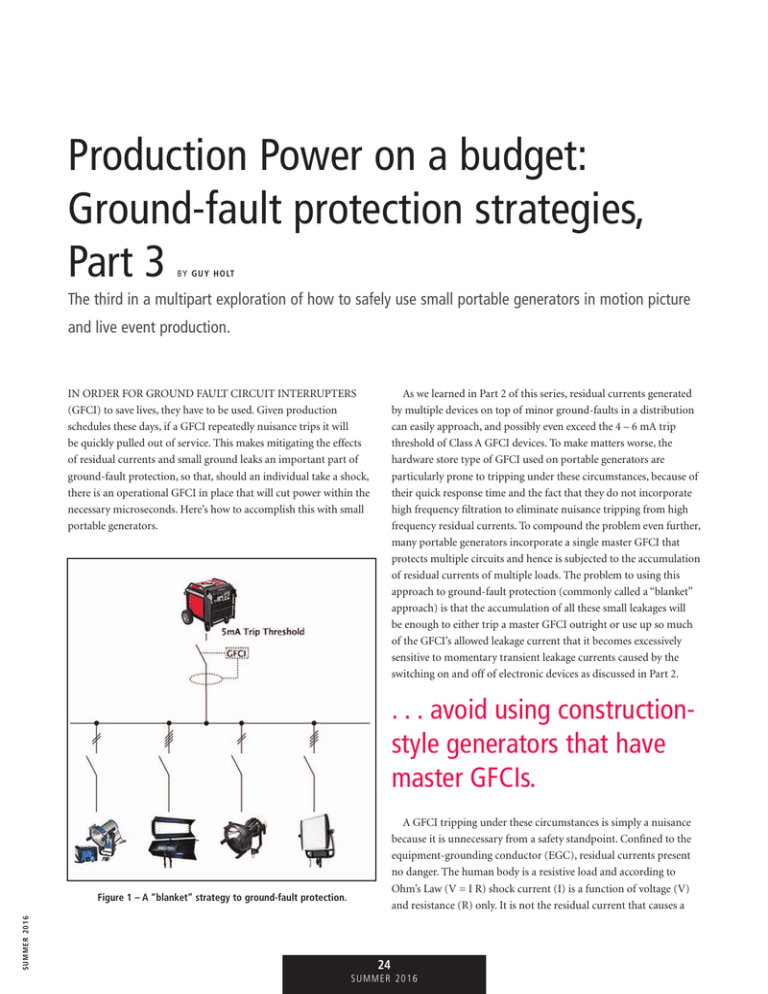
Production Power on a budget: Ground-fault protection strategies, Part 3 BY GUY HOLT The third in a multipart exploration of how to safely use small portable generators in motion picture and live event production. IN ORDER FOR GROUND FAULT CIRCUIT INTERRUPTERS (GFCI) to save lives, they have to be used. Given production schedules these days, if a GFCI repeatedly nuisance trips it will be quickly pulled out of service. This makes mitigating the effects of residual currents and small ground leaks an important part of ground-fault protection, so that, should an individual take a shock, there is an operational GFCI in place that will cut power within the necessary microseconds. Here’s how to accomplish this with small portable generators. As we learned in Part 2 of this series, residual currents generated by multiple devices on top of minor ground-faults in a distribution can easily approach, and possibly even exceed the 4 – 6 mA trip threshold of Class A GFCI devices. To make matters worse, the hardware store type of GFCI used on portable generators are particularly prone to tripping under these circumstances, because of their quick response time and the fact that they do not incorporate high frequency filtration to eliminate nuisance tripping from high frequency residual currents. To compound the problem even further, many portable generators incorporate a single master GFCI that protects multiple circuits and hence is subjected to the accumulation of residual currents of multiple loads. The problem to using this approach to ground-fault protection (commonly called a “blanket” approach) is that the accumulation of all these small leakages will be enough to either trip a master GFCI outright or use up so much of the GFCI’s allowed leakage current that it becomes excessively sensitive to momentary transient leakage currents caused by the switching on and off of electronic devices as discussed in Part 2. . . . avoid using constructionstyle generators that have master GFCIs. A GFCI tripping under these circumstances is simply a nuisance because it is unnecessary from a safety standpoint. Confined to the equipment-grounding conductor (EGC), residual currents present no danger. The human body is a resistive load and according to Ohm’s Law (V = I R) shock current (I) is a function of voltage (V) and resistance (R) only. It is not the residual current that causes a S UM M E R 2 0 16 Figure 1 – A “blanket” strategy to ground-fault protection. 24 S U M M ER 2 0 1 6 means that a construction-style “splitter box” like that pictured in Figure 2 can be used on one of these generators to split out their 240 V receptacle into two 120 V Figure 2 – A construction-style splitter box with circuits. These GFCI protected branch circuits. boxes typically further divide the 120 V circuits into smaller 20 A and 30 A 120 V branch circuits, each protected by a GFCI. This approach, which places the GFCI at the load rather than at the generator, offers some distinct advantages. shock, but the current drawn by the individual making contact with a voltage. Since residual currents do not increase potential, there is no increase in shock hazard even though their accumulation on the EGC can cause a current imbalance that will cause GFCI to nuisance trip. Another drawback to placing a master GFCI on a generator is that even a minor fault in one piece of equipment will take out every piece of equipment operating on the generator. In a music production, a stage can lose all of its back-line power as a result and the band will go mute. In motion picture production, the consequences can be even more catastrophic and possibly even life threatening given the nature of movie production. For example, imagine the typical indie movie set powered by a portable generator at night. Unlike a road crew working at night, a movie crew uses the ambient light generated by the movie lamps illuminating the set as their work light because separate work lights would pollute the lighting effect they are trying to accomplish. Under these circumstances, should a master GFCI nuisance trip the entire distribution system will go down leaving the crew figuratively “in the dark” on where the leak occurred while the entire set is literally left in the dark inhibiting their ability to get the lights back on. Furthermore, if the master GFCI tripped because a crewmember received an actual electrical shock, the darkness will compound the hazard by inhibiting aid being administered to the shocked individual. (For a similar reason, even though NEC 525.23 requires GFCI protection for almost all 15 A and 20 A, 120 V outlets located outdoors, it does not permit egress lighting to be powered by a receptacle protected by a GFCI.) While placement of GFCIs on generators may work adequately in applications involving tools, they clearly do not work in motion picture and event staging applications. So, what is a conscientious technician to do when they have to operate a portable generator in wet hazardous conditions? One could argue that a simple remedy is to not earth ground the generator. According to this argument, if the generator is not grounded with a ground rod, earth cannot serve as a fault path. Fault current will thereby not go to earth and there is no potential exposure to electric shock. While this argument holds some validity for diesel tow plants, which are easily insulated from earth, it does not hold true in the case of small portable generators under 15 kVA. A recent study conducted by The Construction Safety Association of Ontario (CSAO) found that it is very difficult to insulate small generators from earth. In fact, the CSAO study discovered that operating a portable generator on wet ground can earth it, creating a possibly hazardous situation in the event of a fault. What is a conscientious technician to do? First, they should avoid using construction-style generators that have master GFCIs. Since the recent code revisions discussed in Part 1 require GFCI protection only on 20 A and 30 A 120 V receptacles, many generators, like the Honda EU6500 or EU7000 inverter generators, do not have GFCI protection on their 240 V receptacles. Which Figure 3 – A “horizontal discrimination” strategy for ground-fault protection First, it segments the distribution system into zones and thereby reduces the residual and leakage currents seen by any one individual GFCI. If each GFCI has only one or two loads on it, it is less likely to nuisance trip because residual currents are less likely to reach the GFCI’s trip threshold or sensitize it to transient conditions. Second, should the GFCI trip under fault conditions, power is lost only to the individual circuit and not the entire distribution system, making it easier to identify the faulty load. And third, because it is close to the load, the GFCI will more reliably remove dangerous fault conditions because there is less opportunity for fault current SU M M ER 2 01 6 25 P ROTO C O L to return to the neutral conductor before passing through the GFCI’s CT as we saw in Part 1 of this series. Called a “horizontal discrimination” strategy, this approach to ground-fault protection, is still far from ideal. One problem is that the GFCIs used in these distribution boxes are of the inexpensive hardware-type with less lenient trip curves than what is allowed by UL 943. Depending on the type of loads used, these boxes may also be unsuitable because their GFCIs do not incorporate high frequency filtration. For instance, the high frequency residual currents generated by some loads (like the Kino and HMI ballasts discussed in Part 2) will trip these GFCIs even when there is no other load on the circuit (making constructionstyle splitter boxes unsuitable for many event staging and motion picture applications.) . . . for there to be a shock hazard (I>8 mA) there must be a voltage source (V), a closed circuit (someone making contact with two points at different voltage), and a low resistance (R). The only solution to noisy loads is to isolate them to a circuit that is protected by a film-style GFCI further upstream. For example the 100 A Shock Block in Figure 4 above protects both a 4K HMI as well as loads operating on dedicated GFCI protected circuits provided by a GFCI lunchbox in this case. A film-style GFCI that employs high frequency filters and a trip curve that more closely approximates the inverse-time curve of UL 943 will be less prone to nuisance tripping from the accumulated residual currents of these loads. Another problem with a strictly horizontal discrimination strategy is that the main feeder trunk between the generator and the GFCI protected branch circuits (section K in the illustration above) remains without active protection. This hole in protection can expose personnel to shock hazards from something as common as nicked cable insulation. Even absent a clear shock hazard, a strictly horizontal discrimination strategy is inadequate because multiple small faults (each less than 4 mA) that individually won’t trip a GFCI at the load will run together, like many ground springs running together to form a stream, as they all return to their common source, the generator. Under such circumstances, someone touching the generator may receive a severe shock, while someone S UM M E R 2 0 16 Figure 4 – A 100 A/240 V Shock Block GFCI located immediately after the common bus of paralleled Honda EU6500 generators provides blanket protection to the 240 V distribution system. A transformer steps-down the 240 V output of the paralleled generators into a single 100 A/120 V circuit, that can power a large light as well as be broken down into smaller 20 A branch circuits using standard film-style distribution equipment. A 100 A/120 V Shock Block GFCI located immediately after the transformer provides blanket protection to the 120 V distribution system. As a separately derived system, the transformer segments the distribution system in a tiered fashion, while GFCIs on the individual 20 A/120 V branch circuits of the lunch box segment it in a horizontal fashion, thereby eliminating the nuisance tripping of the GFCIs. 26 S U M M ER 2 0 1 6 else touching an individual load with a small leak of less than 4 mA will just experience a tingle. The first step to solving this problem is to use a film-style 240 V GFCI at the generator(s) as depicted in Figure 4. Even though it provides blanket protection, a film-style GFCI will be less prone to nuisance tripping in this position than the master GFCI discussed above because of their high frequency filters and more lenient trip curve. This is only a partial solution however, as a Class A device, its trip threshold (4-6 mA) is low for a GFCI offering blanket coverage. Over an entire distribution system, the 50/60 Hz component of residual current (that we saw in Part 2), on top of small ground leaks, may still cause it to nuisance trip because of its low threshold. Since there are no Class C GFCIs with higher trip thresholds suitable for this application (the smallest available is 200 A per phase, three-phase), the second step towards improving service continuity and system safety is to use a small step-down transformer (like that discussed in Part 2) to step down the 240 V output of the generator to 120 V rather than splitting it out with a constructionstyle splitter box. As a separately derived system a transformer creates a new impedance point to which ground leaks will return rather than return to the generator. Since current returns only to the unique magnetic field from which it was generated, the introduction of a transformer segments the distribution system into two tiers. Only ground leaks upstream of the transformer will return to the magnetic field of the generator’s stator, those downstream will return to the transformer’s core. The net effect is that both the 240 V GFCI at the generator and the 120 V GFCI at the transformer in Figure 4 above see considerably less current imbalance from small ground leaks and so are less prone to nuisance tripping. While segmenting the distribution system in a tiered fashion offers greater protection against nuisance tripping, it is still not ideal because in the event of someone receiving an electric shock all GFCIs (both upstream and downstream) will trip and throw the set into darkness, thereby inhibiting aid being administered to the shocked individual. The reason for this is that the impedance of the human body is such that according to Ohm’s Law both film-style and hardware-style GFCIs will trip at the same time. To see why this would be the case all we have to do is plug some numbers into Ohm’s voltage equation (V= IR). But before we do so, it is important for the math-phobic among us to appreciate that Ohm’s voltage equation is not just an abstract mathematical formula. What it means from a practical standpoint is that for there to be a shock hazard (I>8 mA) there must be a voltage source (V), a closed circuit (someone making contact with two points at different voltage), and a low resistance (R). The degree of hazard (I) is, according to Ohm’s Law, inversely proportional to the resistance of the individual that completes the circuit. For example, a film electrician can be working outside with a defective light and not receive a noticeable shock when the ground is very dry. That same person with the same light can receive a life threatening shock when soaked by rain (real or manufactured) because the resistance of the ground-fault circuit is greatly reduced by the mineral ions in water that make it a good conductor. Under such circumstances, the resistivity of his/her body will determine how much current he/ Figure 5 – A tiered strategy for ground-fault protection. A 100 A/240 V Shock Block GFCI (left) provides blanket protection to the 240 V distribution system. A 100 A/120 V Shock Block GFCI (right) provides blanket protection to the 120 V distribution system derived from the 240 V output of the generators by a step-down transformer. Figure 6 – Body resistance model SU M M ER 2 01 6 27 P ROTO C O L she will draw and consequently the amount of a shock they will take. Put simply, the human body acts like a resistor in an electrical circuit and its resistance, as measured in Ohms, determines how much current will flow in the circuit (a ground-fault circuit in this case.) Figure 6 below depicts a body resistance model (the resistive values are for an average person doing moderate work). To calculate the amount of current our rain-soaked electrician will draw, we use the hand-to-foot resistance of 1,100 ohms (500 + 100 + 500 = 1,100 ohms). Since in this case we are concerned about the effects of current (I) on the human body, we will restate the formula as follows: I = V/R. Plugging numbers into this equation we see that, according to Ohm’s Law, the electrician would take a shock of 0.109 amps (I = 120/1,100 = 0.109 amps.) If we multiply 0.109 amps by 1,000 to convert to milliamps we get 109 mA, which as we learned in Part 1 of this series, will send an individual into cardiac arrest if power is not cut off in less than a second. For this reason, both film-style GFCIs and hardware-style GFCIs are required by UL 943 to trip almost instantaneously (within two hundredths of a second) when leakage current can be lethal. To assure service continuity so that the entire set does not go dark in the event of a catastrophic fault like a shock, upstream and downstream GFCIs must be discriminated by trip time. S UM M E R 2 0 16 Part 4 of this multipart exploration of how to safely use small portable generators in motion picture and live event production will pick up with how to discriminate between upstream and downstream GFCIs by trip time so that only the downstream GFCIs trip in the event of a ground-fault. Gu y H o l t h a s s e r v e d as a gaffer, set electrician, and generator operator o n n u m e r o u s f e a t u r e s and television productions. He is recognized for his w r i t i n g o n t h e u s e o f p ortable generators in motion picture production ( a va i l a b l e s o o n i n b o o k form from the APT Press.) Guy has developed c u r r i c u l u m s o n p o w e r quality and electrical hazard protection that he h a s t a u g h t t h r o u g h t h e IATSE Lo cal 481 Electrical D epartm ent’s “T ECs” P r og ra m. H e i s t h e o w ner o f S creenLight & Grip, a motion picture lighting r e n t a l a n d s a l e s c o m p any that specializes in innovative approaches to set p o w e r u s i n g H on d a p ortable generato rs. 28 S U M M ER 2 0 1 6
